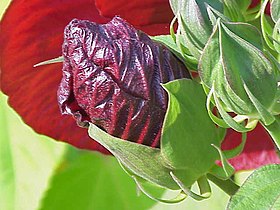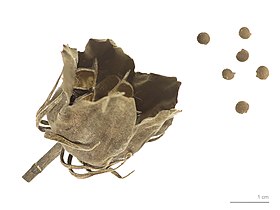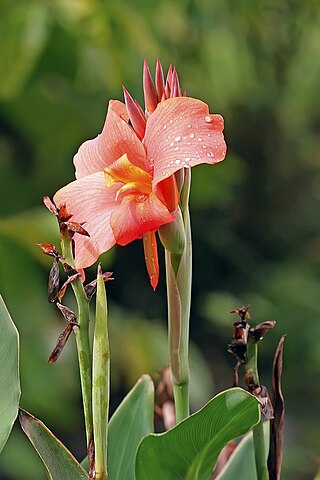
Canna or canna lily is the only genus of flowering plants in the family Cannaceae, consisting of 10 species. All of the genus's species are native to the American tropics and naturalized in Europe, India and Africa in the 1860s. Although they grow native to the tropics, most cultivars have been developed in temperate climates and are easy to grow in most countries of the world, as long as they receive at least 6–8 hours average sunlight during the summer, and are moved to a warm location for the winter. See the Canna cultivar gallery for photographs of Canna cultivars.

Hibiscus is a genus of flowering plants in the mallow family, Malvaceae. The genus is quite large, comprising several hundred species that are native to warm temperate, subtropical and tropical regions throughout the world. Member species are renowned for their large, showy flowers and those species are commonly known simply as "hibiscus", or less widely known as rose mallow. Other names include hardy hibiscus, rose of sharon, and tropical hibiscus.

Malvaceae, or the mallows, is a family of flowering plants estimated to contain 244 genera with 4225 known species. Well-known members of economic importance include okra, cotton, cacao, and durian. There are also some genera containing familiar ornamentals, such as Alcea (hollyhock), Malva (mallow), and Tilia. The genera with the largest numbers of species include Hibiscus, Pavonia, Sida, Ayenia, Dombeya, and Sterculia.

Hibiscus syriacus is a species of flowering plant in the mallow family, Malvaceae. It is native to south-central and southeast China, but widely introduced elsewhere, including much of Asia, both in the east and the west. It was given the epithet syriacus because it had been collected from gardens in Syria. Common names include the rose of Sharon,, Syrian ketmia, shrub althea, and rose mallow. It is the national flower of South Korea and is mentioned in the South Korean national anthem.

Hibiscus rosa-sinensis, known colloquially as Chinese hibiscus, China rose, Hawaiian hibiscus, rose mallow and shoeblack plant, is a species of tropical hibiscus, a flowering plant in the Hibisceae tribe of the family Malvaceae. It is widely cultivated as an ornamental plant in the tropics and subtropics, but its native range is Vanuatu.

Hibiscus trionum, commonly called flower-of-an-hour, bladder hibiscus, bladder ketmia, bladder weed, puarangi and venice mallow, is an annual plant native to the Old World tropics and subtropics. It has spread throughout southern Europe both as a weed and cultivated as a garden plant. It has been introduced to the United States as an ornamental where it has become naturalized as a weed of cropland and vacant land, particularly on disturbed ground.

Hibiscus waimeae is a species of flowering plant within the okra family, Malvaceae, that is endemic to the island of Kauaʻi in Hawaii.

Hibiscus clayi, common names red Kauai rosemallow, Clay's hibiscus or Kokiʻo ʻula, is a perennial angiosperm of the mallow family Malvaceae.

Hibiscus grandiflorus, the large-flowered hibiscus or swamp rosemallow, is a species of flowering plant in the mallow family, Malvaceae. It Is native to the southern United States, from southeast Texas, to southern Florida as well as western Cuba. It is historically known from South Carolina. It favors wet habitats, especially tidal marshes, as well as lakeshores and wet pine savannas. Its flowers serve as a nectar source for hummingbirds, and its fruits provide seeds for other birds.

Hibiscus acetosella, the cranberry hibiscus or African rosemallow, is a flowering plant of the family Malvaceae. The epithet acetosella is of Latin origin and is a diminutive of the Latin name for sorrel which comes from the sour taste experienced when eating the young leaves of both plants. Hibiscus acetosella is also known colloquially as false roselle, maroon mallow, red leaved hibiscus, and red shield hibiscus. It is one of the approximately 200–300 species that are seen in sub-tropic and tropic regions. This ornamental is usually found in abandoned fields or open areas, marshes, and forest clearings. Cranberry hibiscus is a member of a perennial group known as hardy hibiscus. In contrast to the tropical hibiscus, hardy hibiscus can tolerate colder conditions, are more vigorous, longer lasting, and have larger flowers. In colder climates, Hibiscus acetosella is easily an annual, but is often regarded as a perennial to zone 8–11. During one season, the plant can grow 90–170 cm (3.0–5.6 ft) tall and 75 cm (30 in) wide as a shrub-subshrub.

Hibiscadelphus is a genus of flowering plants that are endemic to Hawaiʻi. It is known by the Native Hawaiians as hau kuahiwi which means "mountain Hibiscus". The Latin name Hibiscadelphus means "brother of Hibiscus". It is distinctive for its peculiar flowers, which do not fully open. Hibiscadelphus is in the family Malvaceae, subfamily Malvoideae. Several of the species in this small genus are presumed extinct, as a result of coextinction with their primary pollinators, the Hawaiian honeycreepers.

Lagunaria is a genus in the family Malvaceae. It is an Australian plant which is native to Lord Howe Island, Norfolk Island and parts of coastal Queensland. It has been introduced to many parts of the world. The genus was named for its resemblance to the earlier genus Laguna Cav., which was named in honour of Andrés Laguna, a Spanish botanist and a physician to Pope Julius III.

Hibiscus coccineus, the scarlet rosemallow, is a hardy Hibiscus species, also known as Texas star, brilliant hibiscus and scarlet hibiscus.

Hibiscus calyphyllus, the lemonyellow rosemallow, is a shrub from tropical Africa belonging to the genus Hibiscus. In 1883 this Hibiscus was offered for sale in England under the name Hibiscus chrysanthus with Port Natal, Cape Colony, identified as the source. By 1891 the same Hibiscus was identified as Hibiscus chrysantha in the United States, a practice which may have continued into the 1930s and contributed to incorrect species identification. In 1892 the name Hibiscus calycinus was designated as the correct name for the species; but, by 1894 the currently accepted name Hibiscus calyphyllus is found in association with Hibiscus calycinus. At the beginning of the 20th century, this Hibiscus was sold as seeds in the United States under the name Hibiscus Giant Yellow. Because of the similarity of the flowers, it is quite common to find Abelmoschus manihot confused with Hibiscus calyphyllus in the early 20th century gardening literature of the United States, particularly in the area of cold tolerance. If the species identification is correct, the 1903 report in The Flower Garden states that: "Giant Yellow is a beautiful canary yellow with crimson throat, hardy as far north as St. Louis, but safer in the cellar above that latitude", then Hibiscus calyphyllus may have some degree of cold tolerance. St. Louis, Missouri is in USDA Zone 6a but there are currently no reports of Hibiscus calyphyllus overwintering in USDA Zone 6a; it is known to overwinter successfully in USDA Zone 8a.
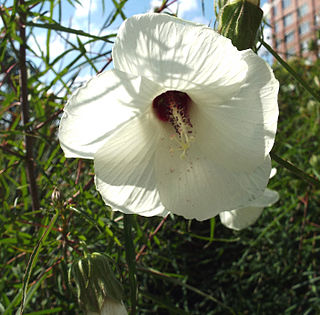
Hibiscus dasycalyx is a species of hibiscus known by the common name Neches River rosemallow. It is endemic to Texas in the United States, where there are three remaining natural populations and three introduced populations.
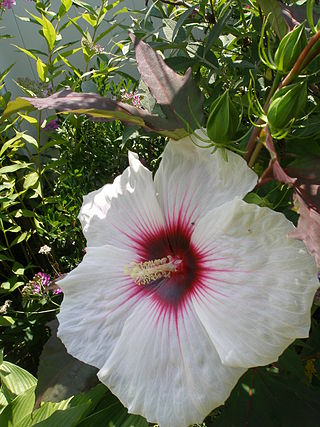
Hibiscus 'Kopper King' is a cultivar of Hibiscus that has large, showy flowers and copper-colored lobed leaves. It was bred and selected for its aesthetic attributes as well as its cold hardiness to at least −30 °F (−34 °C) by Jim, Bob, and Dave Fleming of Fleming's Flower Fields in Lincoln, Nebraska. 'Kopper King' is a compact perennial shrub, reaching 3–4 ft (0.9–1.2 m) tall with a 2–4 ft (0.6–1.2 m) spread. The leaves are coppery red to dark purple, with a lobed and toothed leaf shape that appears to be similar to some maples. New growth will emerge in late May or early June and the plant will bloom from midsummer to early fall at the first frost. Each flower, with its cream to light-pink petals and deep red eye in the center streaking outward toward the margin, is borne singly from the leaf axils and can be 8–12 in (20.3–30.5 cm) in diameter. Each flower only lasts one day but new blooms are typically produced in succession, allowing for almost continuous flowering. The flower display is flat with petals overlapping. Overall, the plant is resistant to pests and diseases, although it can be severely damaged by Japanese beetles.
Iris nelsonii is a species in the genus Iris, it is also in the subgenus Limniris and in the series hexagonae. It is a rhizomatous perennial, from northern America. It has long drooping, grass-like leaves, tall stems, 10 red-purple flowers.

Ptilothrix is a genus within the tribe Emphorini of the family Apidae. Bees of this genus can range from 7 to 15 mm. Ptilothrix species are solitary, ground-nesting bees. These bees have especially prominent hairs in the scopae of their hind legs, to help gather pollen to provision their nests. Ptilothrix species specialize on certain families of plants for their pollen, including the families Malvaceae, Convolvulaceae, Onagraceae, Cactaceae, Pontederiaceae, and Asteraceae. The genus is found in the New World, with species ranging across the Americas.

Hibiscus hamabo, the hardy yellow hibiscus, is a species of shrub in the genus Hibiscus that is native to the coastlines of China, Japan, and Korea. It is characterized by yellow flower coloring as well as orbicular shaped leaves. In its native environment it is a perennial.

Hibiscus coulteri, the desert rosemallow, is a species of flowering plant in the family Malvaceae. It is native to steep slopes and canyon walls in the eastern Sonoran Desert, and the Chihuahuan Desert of the southwestern US and northern Mexico. A short-lived perennial shrub reaching 6 ft (1.8 m), it is recommended for xeriscaping.



